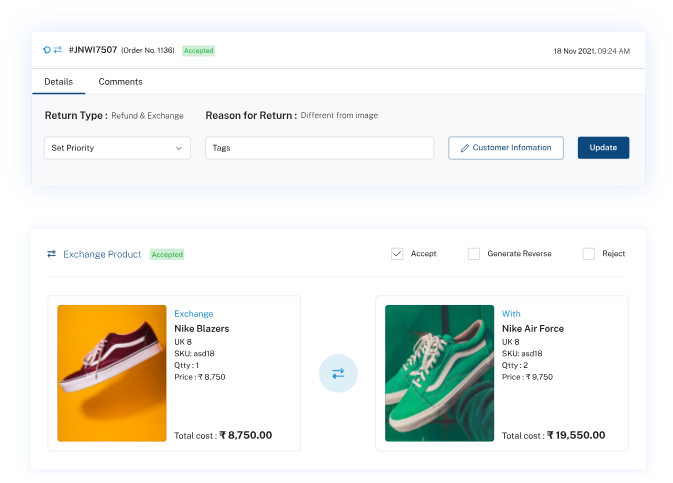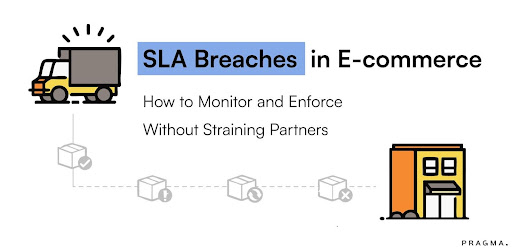When customers receive products that don't meet their expectations, they typically have three options.
- Replacement
- Exchange, or
- Refund
Replacement is the process where a customer receives the same product as originally ordered when the initial item is either defective, damaged, or not as advertised.

Exchange involves returning an item and receiving a different product of equal cost. It is common when customers want to change for a different size, colour, or model variant.
Refund is the process where customers return a product they no longer need and receive their money back through the same payment method used for the purchase.
While these concepts may sound similar, they present different implications for any DTC brand, and this blog explores those key differences between replacement vs exchange vs refund policies.
How to Reduce Return to Origin Shipments?
Returns You Can Trust
Fast. Fair. Hassle-Free.
Give your customers the confidence to buy, every time. Pragma’s RMS powers transparent, easy returns across every channel, delivering instant updates, clear policies, and five-star support.
Experience why top brands earn better reviews and more repeat business when returns are stress-free.
How to Process Refunds Faster and Cut Complaints?
- Speedy refunds boost loyalty and lower negative feedback, especially in high order volume periods.
- Set clear internal SLAs, strive for most refunds to be completed within 24–48 hours post-approval.
- Proactively communicate every status via email, SMS, and WhatsApp to set expectations and reduce anxiety-driven complaints.
What is a Replacement Policy?

A replacement policy outlines the conditions under which customers can demand the same product when the original item doesn't meet expectations.
For instance, if a shopper orders a blue shirt in size medium and receives one with a quality defect, you, as the seller, will send them another blue shirt in size medium.
Replacement Policy Key Points:
- Eligibility criteria: Specifies conditions under which replacements are offered (e.g., damaged items, missing parts, or products that don't function as described)
- Timeframe: Defines the window during which customers can request replacements, typically ranging from 7 to 30 days after delivery
- Documentation requirements: Details what evidence customers need to provide (photos of defects, videos showing malfunctions)
- Process steps: Outline how customers can initiate and complete the replacement request
- Shipping arrangements: Clarifies who bears the cost of returning the original item and delivering the replacement
It is especially helpful for electronic goods, household appliances, and other products where customers specifically want the exact model they ordered but in proper working condition.
Be sure to "clearly state it prominently, in bold type in more than one place on your returns page" to set proper expectations for buyers.
What is an Exchange Policy?
Unlike replacements that provide the same item, exchanges allow customers to choose alternatives when the original product doesn't meet their needs in terms of size, colour, or other preferences.
For example, exchanging the blue shirt in medium for a red shirt in medium, or for a blue shirt in large.
Invesp states that "67% of shoppers review a retailer's exchange and return policy before making a purchase," highlighting the immediate need for clear exchange guidelines.
Exchange Policy Key Points:
- Exchange eligibility: Defines which products qualify for exchange (usually excluding personalised items or sale merchandise)
- Exchange window: Specifies the timeframe during which exchanges are permitted
- Condition requirements: Outlines the acceptable condition for exchanged items (e.g., unworn, tags attached, original packaging)
- Value adjustment: Explains how price differences are handled if the replacement item costs more or less
- Exchange limits: States any restrictions on the number of exchanges permitted per order
- Documentation: Details what receipts or order information customers must provide
What is a Refund Policy?

A refund policy describes the conditions under which customers can return products and receive their money back.
Refund Policy Key Points:
- Refund eligibility: Specifies which products can be returned for refunds and under what circumstances
- Refund timeframe: Establishes the period during which refunds are accepted (typically 7-90 days after purchase)
- Return condition requirements: Outlines the acceptable condition for returned items
- Refund method: Clarifies whether refunds are issued to the original payment method, as store credit, or through other means
- Processing timeline: Indicates how long it takes for refunds to be processed after items are returned
- Non-refundable items: List products exempt from the refund policy (e.g., perishables, downloadable content)
Having a return policy that's clearly worded and easy to find builds trust with your customers and leaves no room for frustration.
This transparency is important, considering the Consumer Protection Act in India mandates businesses to have clear refund policies, with regulations stipulating that refunds must be processed within 15 days of the cancellation or return request.
Perks of Exchange or Replacements
Offering proper exchange and replacement policies to consumers brings significant advantages in the buying journey.
- Exchanges and replacements help you retain the revenue within the business, unlike refunds, where money is often lost.
- Allowing replacements for defective or unsatisfactory products can be more cost-effective than processing returns and refunds.
- Quick replacements for defective items show your brand's commitment to product quality.
- Exchanges allow customers to find the right product without abandoning the purchase altogether.
- Replacements often require less processing than full refunds
- Exchange policies can reduce the administrative burden by simplifying the return-to-inventory process
- Exchanges create opportunities for customers to select higher-value alternative products
Drawbacks of Refunds
While refunds are sometimes necessary, they present several challenges like
- Complete loss of sales revenue
- Processing refunds incurs transaction fees and administrative expenses
- Brands often bear shipping costs in both directions without generating revenue
- Returned items may not be resellable at full price or may require inspection and repackaging
- Large volumes of refunds can create cash flow problems, particularly for smaller brands
- Delayed refund processing can lead to customer dissatisfaction and complaints
- Refund processes that are slow or complicated can compromise customer experience
- The LocalCircles survey highlighted that "Only four out of 10 shoppers who ended up with counterfeit or fake items were able to get them exchanged or refunded."
Exchange/Replacement/Refund - A Brand's POV

From a brand's perspective, the choice between offering replacements, exchanges, or refunds depends on
Workflow Impact
Replacements might require maintaining additional inventory to fulfill requests quickly.
Exchanges often create more complex return processing workflows, requiring your team to handle incoming and outgoing orders.
Refunds require financial processing and potentially restocking returned items, resulting in additional administrative overhead.
Brand Reputation Management
The return experience also influences how customers perceive your brand.
Giving consumers a smooth, hassle-free return system builds trust and encourages repeat business.
Data Utilisation
Return patterns unveil valuable information for product development and marketing.
Use it to analyse return reasons to improve product descriptions, quality control processes, or design elements.
This feedback loop will reduce your future returns by addressing common customer issues at their source.
Exchange/Replacement/Refund - A Customer's/Buyer's POV
From the customer's perspective, the differences between replacement, exchange, and refund options do impact their shopping confidence and satisfaction to some extent.
Purchasing Confidence
When customers know they have options if something goes wrong, they're more likely to complete their purchase without hesitation.
Convenience Factors
Obtaining a replacement generally takes less effort than finding an alternative product during an exchange process, which may require browsing through options and making new decisions.
Speed of Resolution
The BrandEquity survey found that 40% of customers face difficulty reaching human support during return processes, underscoring how vital efficient and accessible return systems are to customer satisfaction.
Financial Flexibility
Refunds allow customers to spend their money elsewhere, including with competitors.
Exchanges keep the customer's spending within the same brand but allow product switching.
Replacements offer no cost flexibility but directly address product issues with minimal hassle.
Key Differences Between Replacement and Exchange and Refunds

Note: According to the Consumer Protection Act in India, customers have "the right to return any semi-durable or durable products purchased free of charge within 15 days of purchase if they are returned in their original condition."
How E-commerce Platforms in India Implement These Policies
E-commerce platforms in India have created varied approaches to handling returns.
Amazon India
- Consistently rated highest for customer-friendly return policies
- From the NDTV report, "Amazon emerged as the most trusted platform for returns and refunds, with 79% of respondents endorsing its policies"
- Offers all three options – replacements, exchanges, and refunds – with transparent processes for each
Flipkart
- Implements category-specific return policies
- Recently faced legal challenges regarding return policies
- The Deccan Herald reports stated a recent case where "Flipkart was fined Rs 10,000 by a District Consumer Redressal Forum in Mumbai for refusing to take back a nutrition supplement from a consumer"
Smaller platforms
- Often have more restrictive policies
- The LocalCircles survey concluded that "marketplaces like Meesho and Ajio were rated the least favourable" for returns.
- Some platforms manipulate "no replacement" policies to avoid responsibility for poor-quality items.
Implementation challenges
- The Times of India highlighted a case where a customer had to approach a consumer court to get a refund of Rs 3,499 for a smartwatch.
- Similarly, TheWeek reported, "nearly half of all online shoppers ended up with at least one wrong product over the past year"
- From the BrandEquity survey, around "40% of customers face difficulty in reaching a human agent, as they get stuck in endless chatbot loops"
Legal Rights of Consumers in India for Returns
Indian consumers have specific legal protections regarding e-commerce returns:
Consumer Protection Act, 2019
- Establishes the foundation for consumer rights in e-commerce
- Create the Central Consumer Protection Authority to oversee returns and refunds
- Law4u explains that the Act "grants consumers the right to returns, refunds, and cancellations if the product or service doesn't meet expectations"
E-Commerce Rules, 2020
- Mandates clear return and cancellation policies
- Requires that policies be easily accessible to consumers
- According to Law4u, these rules "make it mandatory for e-commerce platforms to provide a simple, transparent process for consumers to return products or cancel orders without facing unreasonable hurdles"
Cooling-off period
- Indian law provides a standard cooling-off period
- The Law4u advocates state that "Indian law provides a cooling-off period (typically 14 days) for consumers who change their mind after purchasing a product online"
Refund timelines
- Legally mandated timeframes for processing refunds
- Law4u also notes that "refunds must be processed within 15 days of the cancellation or return request"
Consumer redressal mechanisms
- Multiple forums for addressing unresolved issues
- The Legal Services of India document explains that "If your complaints are not addressed, you have one last option: go to the consumer forum or the consumer court and file a complaint against the supplier"
Best Return Practices for E-commerce Brands
Here are the best practices for e-commerce brands to manage replacement, exchange, and refund policies.
Policy Clarity and Accessibility: Make your return policies easy to find on your websites and apps using simple, jargon-free language that customers can easily understand and visuals to break down complex items.
Process Simplification: Provide customers with digital return portals post-purchase for self-service and user-friendly return processes so customers can manage returns on their own.
Communication Excellence: Proactive communication instructions to shoppers when they raise return requests and follow up after the process is completed.
Fraud Prevention: Set up verification processes requiring proof of purchase to track return patterns, mitigate return fraud risks, and flag suspicious behavior.

Image caption: Return Fraud Process
Omnichannel Integration: Provide in-store returns for online purchases as it creates additional touchpoints with customers and opens up potential opportunities for additional sales during the return visit.
How Pragma Helps Businesses with Returns & Exchanges
Pragma's Return Management System offers a complete suite of features to help brands like you handle replacements, exchanges and refunds easily.

Fully Automated Returns Management
It helps you deliver a superior customer experience through
- Branded returns portal that matches your brand’s look and feel
- Customisable policies based on products, categories and seasonal requirements
- Automated Return Merchandise Authorisation (RMA) to verify return eligibility using mail order number

- Seamless courier integration with automatic AWB generation for reverse logistics
Benefits
Pragma's return management delivers several improvements to your bottom line, including.
- Revenue retention through encouraging exchanges rather than refunds
- Reduced manual effort by up to 80% with automated processing
- Improved customer satisfaction with quick, transparent handling
- Valuable data insights to identify product issues and improve quality control
It gives you complete control over your return policies while providing customers with the flexible, friction-free experience they expect.
To Wrap It Up
As e-commerce continues to grow in India, with return rates ranging from 15-30% across categories, proper return management will increasingly differentiate successful online brands from the rest.
By carefully addressing replacement vs exchange vs refund policies, you not only cut unnecessary costs but also build stronger customer trust that drives long-term growth.

FAQs (Frequently Asked Questions On Replacement vs Exchange vs Refund)
Can a customer return a Mobile phone if I don't like it?
It depends on your brand policy. Some allow returns for preference-based reasons within 7-30 days, provided the device is unused with original packaging.
Is a refund a replacement or an exchange?
No. A refund returns money to the customer, whereas replacement provides the same item again, and exchange offers a different product of similar value.
Can a consumer insist on a replacement for faulty goods?
Yes. Under the Consumer Protection Act in India, customers can demand a replacement for defective products received within the specified timeframe.
When is it better to offer a replacement instead of an exchange or refund?
Use replacement when the original product was defective but the customer wants the same item.
How does exchange processing affect inventory compared to refunds?
Exchanges require forward logistics and updated stock management, while refunds remove the sale entirely.
Which scenarios call for refunds versus exchanges?
Refunds suit when the customer no longer wants a product; exchanges when the customer desires a different size, color, or item.
How can brands steer customers toward exchanges to increase retention?
By incentivizing exchanges with perks like free shipping or store credits instead of offering full cash refunds.
How should policies for replacement, exchange, and refund be communicated clearly?
Policies should be simple, visible at purchase & support points, and explain eligibility, timelines, and processes clearly.
Talk to our experts for a customised solution that can maximise your sales funnel
Book a demo



.png)
.png)